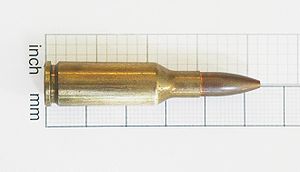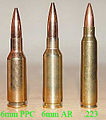6 mm PPC
| 6 mm PPC | |
|---|---|

|
|
| general information | |
| caliber | 6 mm PPC |
| Sleeve shape | Bottle neck sleeve, rimless with pull-out groove |
| Dimensions | |
| Floor ⌀ | 6.17 mm |
| Cartridge bottom ⌀ | 11.18 mm |
| Sleeve length | 38.18 mm |
| Cartridge length | 55.70 mm |
| Weights | |
| Bullet weight | 3.56–6.48 g (55–100 grain ) |
| Powder weight | up to 1.94 g (30 grain ) |
| total weight | approx. 11 g |
| Technical specifications | |
| Speed v 0 | approx. 1000 m / s |
| Max. Gas pressure | 4050 bar |
| Bullet energy E 0 | 2250 y |
| Lists on the subject | |
The 6 mm PPC (Palmisano & Pindel Cartridge) is a rifle cartridge that was developed in 1975 by the Americans Louis Palmisano and Ferris Pindell from the Soviet hunting cartridge 5.6 × 39 mm .
development
Palmisano and Pindel developed the cartridge especially for bench rest competitions with the aim of high precision. It is used in competitions at distances of 100, 200 and 300 yards (1 yd = 91.44 cm) and for pest hunting.
background
The Soviet 5.6 × 39mm cartridge has been used for hunting sports in the Soviet Union since the 1950s. Due to the close ties to Finland and the fact that the 7.62 × 39 mm was Finnish ordinance ammunition, this caliber was also manufactured in Finland by SAKO and later Lapua from around 1965. The Finnish manufacturers originally kept the metric designation, but export ammunition for the North American market was marked with .220 RUSSIAN . The Finnish cartridges differed from the original Soviet ones in their brass cases and other projectiles.
The creation of the 6 mm PPC
Palmisano and Pindel were looking for the optimal bench rest cartridge. They used Finnish SAKO cases made of brass with a caliber of 5.6 × 39 mm. They widened these to .243 "and increased the flank angle to 30 ° using fire shapes. The case of 5.6 × 39 mm was particularly well suited for this because it has a solid case base and a narrow ignition channel. Target shooters in the USA are in usually reloaders and manufacture their own ammunition. Although SAKO and Norma now manufacture factory ammunition in caliber 6 mm PPC, benchrest shooters mainly use .220 Russian cases to produce their match ammunition, as factory ammunition does not achieve the same precision.
SAKO standardized the cartridge in 1985 according to the SAAMI standard. The ammunition manufactured according to this standard is marked with 6PPC USA .
properties
The 6 mm PPC differs from the 5.6 × 39 mm cartridge in that it has a steeper flank angle of 30 ° and the wider cartridge neck. Due to the short sleeve (38.2 mm) and the steep sleeve shoulder reaching a higher efficiency than any other 6-mm cartridge.
With precisely loaded cartridges, a suitable rifle and a lot of practice, groups of 5 or 10 rounds under 5 mm at 200 yards (180 m) are possible.
Size comparison with the 6 mm AR and the .223 Remington
Further developments
From the 6 mm PPC, Arne Brennan developed the 6.5 mm PPC as Wildcat. From the 6.5 mm PPC, Brennan later developed the 6.5 mm Grendel together with Bill Alexander from Alexander Arms and Janne Pohjoispää from Lapua . The shoulder angle of 30 ° was retained, the neck was lengthened and the wall thickness of the neck increased. The 6 mm AR was in turn derived from the Grendel by pulling in a Grendel sleeve to 6 mm.
literature
- Friedhelm Kersting: Reloading . Preparation and practice. Cartridges for long and short guns. 5th supplemented and revised edition. German experimental and testing institute for hunting and sporting weapons e. V, Altenbeken 2005, ISBN 3-00-016629-7 .
- Hans Heigel: Proof of precision . Ammunition comparison 6 mm PPC and 6 mm PPC USA. In: Deutsches Waffen-Journal . dwj, March 2012, ISSN 0341-8936 ( henke-online.de [PDF]).
Web links
Individual evidence
- ↑ CIP 6 mm PPC (PDF; 36.8 kB) ( Memento from October 19, 2017 in the Internet Archive )
- ^ Layne Simpson: The 20th Century's Top Rifle Cartridge. In: Shooting Times . February, 2000; found on About.com .
- ^ Competition Cartridges - A Brief History of Cartridge Design. 6mmbr.com, accessed on April 27, 2013 (English, The 5.6 × 39 mm itself was derived from the 7.62 × 39 mm .).
- ↑ 6MM PPC - The Benchmark of Accuracy. 6mmbr.com, 2005, accessed April 28, 2013 .
- ↑ 5.6x39 from 7.62x39 Kalashnikov / 5.6x39 / 5.6 Russich / 5.6 Vostok / 5.6 Sportivnyi / .220 Russian / 5.6 Russian Match / 5.6 Russian Short / .223 Russian / .22 Russian / SAA 0535 (Russian) SAA 0545 (Finnish) / XCR 06 039 BGC 010. municion.org, accessed April 28, 2013 (Spanish).
- ↑ Heinz Henke: Interesting for reloaders. henke-online.de, accessed on April 28, 2013 .
- ↑ Pat Farey: Case Histories: 6 mm PPC. Retrieved April 28, 2013 .
- ↑ 6MM PPC - The Benchmark of Accuracy. 6mmbr.com, 2005, accessed April 28, 2013 .
- ↑ Chuck Hawks: The 6 mm PPC-USA. 2005, accessed April 28, 2013 .
- ↑ 6PPC. municion.org, accessed April 28, 2013 (Spanish).
- ↑ Arne Brennan: 6.5 Grendel - Origins and Performance. 6mmbr.com, accessed April 27, 2013 .
- ↑ J. Guthrie: 6.5mm Grendel: The Round the Military Ought to Have. shootingtimes.com, accessed April 27, 2013 .

